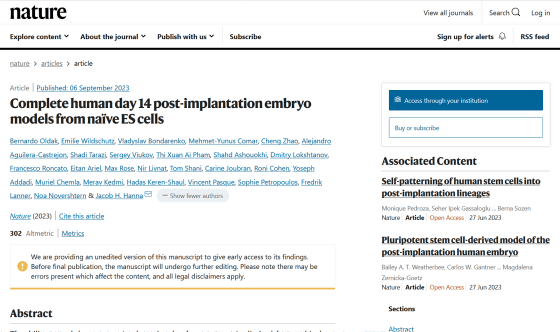Succeeded in creating ``almost complete model of human embryo 2 weeks after development'' from cultured stem cells, potentially useful for research in the mysterious early stage of development

In recent years, research to create human organs and organs from cultured stem cells is progressing, and attempts to
Complete human day 14 post-implantation embryo models from naïve ES cells | Nature
https://www.nature.com/articles/s41586-023-06604-5

Human Embryo Models Grown from Stem Cells - Life Sciences | Weizmann Wonder Wander - News, Features and Discoveries
https://wis-wander.weizmann.ac.il/life-sciences/human-embryo-models-grown-stem-cells
'Complete' models of human embryos created from stem cells in lab | Stem cells | The Guardian
https://www.theguardian.com/science/2023/sep/06/complete-models-of-human-embryos-created-from-stem-cells-in-lab
Research into artificially creating organs and organs using stem cells has progressed rapidly in recent years. Hanna et al.'s research team has developed a method to reprogram pluripotent stem cells that can differentiate into almost all cells that make up the body and return them to a state called undifferentiated `` naive human stem cells ''.
By chemically treating this naive human stem cell, the research team created a group of cells intended to develop into embryos, a group of cells intended to grow into placenta, yolk sac , extraembryonic mesoderm , etc. . And when these cell groups were mixed under optimized conditions, the cells formed clumps, about 1% of which were arranged in a complete embryo-like structure.
This freshly constructed model embryo had structures comparable to human embryos after 1 week of development, developed normally outside the uterus for 8 days, and reached developmental stages comparable to human embryos after 2 weeks of development. According to the research team, the model embryo at the stage corresponding to 1 week after development was composed of about 120 cells, and the size was about 0.01 mm, but at the stage corresponding to 2 weeks after development, about 2500 cells. It seems that they gathered together and grew to about 0.5mm in size.
'Embryos are by definition self-driven. They don't need to be told what to do, they just unleash their internally encoded potential,' Hanna said. It's important: it can only be derived from naive stem cells, which have no developmental restriction.'
This model embryo had the same structural features as a human embryo of the same age, such as the placenta and yolk sac, and not only was the structure and support structures in the correct position, but the size and shape were also appropriate. In addition, the research team reports that there are even cells that produce hormones that are used as criteria for pregnancy tests, and that the pregnancy test kit actually detected secretions from the model embryo and determined that it was positive (pregnant). Masu.

Human embryos become structured embryos containing body organs within 3-4 weeks of development, but early human embryos are difficult to study due to ethical and technical issues. ``The big drama of pregnancy is in the first month, and the remaining eight months are mainly growth, but that first month is still largely a black box,'' Hannah said. . The model created this time emulates the processes necessary for the early human embryo to develop into a fetus, and is expected to help study the mysterious early human embryo. .
'Many failed pregnancies occur in the early weeks of development, often before a woman realizes she is pregnant,' Hannah said. 'Early development also causes many birth defects. Sometimes, but they tend to be discovered much later, our model reveals the biochemical and mechanical signals that ensure proper development at this early stage, and why development goes wrong. It can be used for
In fact, in this experiment, it is also known that internal structures such as the yolk sac do not develop properly unless the embryo is properly wrapped in placenta-forming cells at the stage corresponding to 10 days after human embryogenesis.
Dr. Peter Lag Gun, who studies human embryos at

Related Posts:
in Science, Posted by log1h_ik







